2. 西藏地质矿产勘查开发局第五地质大队, 格尔木 816000;
3. 中国地质调查局成都地质调查中心, 成都 610081;
4. 西藏地质矿产勘查开发局, 拉萨 850000
2. No.5 Geological Party, Tibet Bureau of Geology and Mineral Exploration and Development, Glomud 816000, China;
3. Chengdu Center, China Geological Survey, Chengdu 610081, China;
4. Tibet Bureau of Geology and Mineral Exploration and Development, Lhasa 850000, China
斑岩Cu(Au)矿床和高硫型浅成低温Cu(Au)矿床普遍发育于板块构造边缘的俯冲构造背景下,一般与陆缘弧钙碱性岩浆相关(Hedenquist and Lowenstern, 1994; Qin and Ishihara, 1998; 李金祥等, 2006; Sillitoe, 2010; Richards, 2013; Liu et al., 2018)。现今巨型的斑岩型铜矿都集中在环太平洋、特提斯和中亚这三个构造岩浆岩带上(Cooke et al., 2005; Richards, 2013);并表现为呈群、呈带分布,且集中某一个地质时期,通常形成于构造体制的转换阶段(Sillitoe, 1997; Kerrich et al., 2000; Qin et al., 2005)。西藏班公湖-怒江带是特提斯成矿带的一部分,近年来在该带找矿取得了巨大的突破,成为继玉龙和冈底斯斑岩成矿带之后的第三条重要的成矿带(李金祥等, 2008; Li et al., 2013, 2018; 唐菊兴等, 2016)。西藏地勘局地质五队2000年在该成矿带发现多不杂大型斑岩Cu(Au)矿床以来,近20年的时间在多不杂外围新发现10余处矿床(点),构成超大型多龙斑岩-浅成低温Cu(Au)矿集区(Cu远景储量2500万吨,Au储量400吨;李玉彬等,2012;唐菊兴等,2016),其中包括斑岩型Cu(Au)矿(波龙等)、高硫型浅成低温Cu(Au)矿(如拿顿等)、斑岩-高硫型浅成低温热液型Cu矿(如铁格隆南/荣那矿段)及与角砾岩筒有关的Au-Cu矿床(如色那等)(表 1)。尽管前人已经对矿集区相关矿床的蚀变矿化特征、年代学、成矿流体、岩石成因及构造背景等方面进行了大量研究(李光明等, 2007, 2015;李金祥等,2008;Zhu et al., 2015; Li et al., 2017b; Lin et al., 2017; Sun et al., 2017; Song et al., 2018; Zhang et al., 2018),但是对在多龙矿集区西部新发现的拿厅大型Cu(Au)矿床研究较为薄弱。
|
|
表 1 西藏班公湖-怒江带多龙矿集区主要矿床地质特征 Table 1 Major characteristics of the ore deposits in the Duolong district, Bangong-Nujiang metallogenic belt, Tibet |
拿厅斑岩Cu(Au)矿床位于班公湖-怒江缝合带北侧、改则县北西100km、羌塘南缘的多龙矿集区(图 1a)。该矿床探明资源量已达大型规模(Cu资源量>100万吨,Cu平均品位>0.3%;伴生Au资源量>100吨,Au平均品位>0.2g/t),属于矿集区新发现的具有较大规模的斑岩型矿床。由于该矿床是新发现的矿床,相关研究工作极为薄弱,亟待深化。林彬等(2016)、韦少港等(2017)对地堡那木岗(拿厅北西侧;图 1b)矿区内花岗闪长斑岩及二长花岗斑岩进行了锆石年代学、Hf同位素及相关岩石成因的研究。乔东海等(2017)利用流体包裹体、硫化物的硫同位素结合电子探针分析研究,对拿厅矿床的成矿流体和成矿物质来源进行了初步的研究,指出该矿床是具有明矾石和硫砷铜矿矿物组合的典型高硫型浅成低温热液矿床。但通过我们详细地质观察发现,该矿床主要是斑岩型矿床,局部具有高硫型浅成低温矿化的叠加。目前,对拿厅矿区斑岩成矿阶段的地质特征、成岩斑岩时代、成岩成矿物质源区和构造背景还缺乏清晰的认识。本文在详细地质勘查工作基础上,结合系统岩相学观察、精细的SIMS锆石U-Pb定年、原位锆石Hf-O同位素、岩石化学和H-O-S同位素分析,结合前人的研究成果,开展了矿床地质特征、岩浆岩年代学、成岩-成矿物质源区特征的研究,提升对班公湖-怒江成矿带斑岩型铜(金)矿床的成岩-成矿过程的认识。
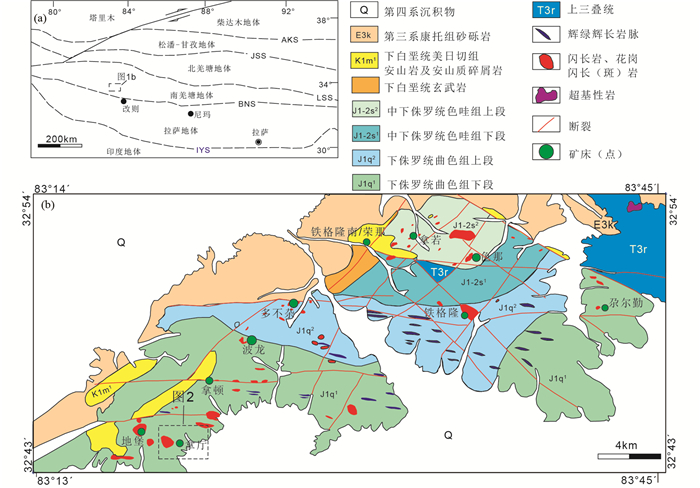
|
图 1 青藏高原大地构造(a)和多龙矿集区地质图(b)(据西藏地质调查院,2012①修改) Fig. 1 Tectonic map of the Tibet Plateau (a) and geological map of the Duolong ore cluster (b) |
① 西藏地质调查院.2012.西藏班公湖-怒江成矿带西段铜多金属资源调查报告
1 多龙矿集区和拿厅斑岩Cu(Au)矿床的地质特征多龙矿集区位于南羌塘地体南缘的中生代构造岩浆弧中(图 1a),系班公湖-怒江洋向北俯冲的产物(Li et al., 2014)。而分隔南羌塘和拉萨地块的班公湖-怒江缝合带,其北界为班公错-康托-兹格塘错断裂,南缘为日土-改则-丁青断裂,主要由规模巨大的蛇绿岩及混杂岩带构成不规则的狭长带状,东西长达2000km,南北宽30~90km。在这两条区域性断裂之间,发育着近EW向规模不等的压扭性-韧性剪切、脆性走滑断裂、SN向张性断裂和NW向、NE向张扭性、压扭性断裂及近东西向的褶皱构造,并伴有燕山期基性岩和中酸性岩侵入。研究显示班公湖-怒江洋至少从石炭纪到早侏罗世就已存在(Shi et al., 2008; Pan et al., 2012),但对于班怒洋的闭合时代尚有争议,部分研究者认为于晚侏罗-早白垩世闭合(Kapp et al., 2005; Zhu et al., 2013; 曲晓明等,2015),而蛇绿岩、放射虫的年龄及火山岩的研究显示南羌塘和拉萨地体的碰撞大约发生在100Ma(Baxter et al., 2009; Zhang et al., 2012; Liu et al., 2014)。
多龙斑岩-浅成低温热液Cu(Au)矿集区呈近东西展布,长约30km、南北宽约10km(图 1b)。矿集区内出露地层由老到新主要为:中生界上三叠统日干配错群(T3r)、下侏罗统曲色组(J1q)、中-下侏罗统色哇组(J1-2s)、下白垩统美日切错组(K1m)、新生界新近系康托组(E3k)和第四系(Q)。其中下三叠统日干配错群(T3r)仅在矿集区的北东侧昂隆一带呈断块少量出露,为一套陆棚浅海相碳酸盐建造,与上覆的新近系康托组(E3k)呈角度不整合接触关系。下侏罗统曲色组(J1q)总体呈北东向展布,是一套次深海陆棚-盆地斜坡复陆碎屑岩复理石建造;曲色组下段(J1q1)为灰白色中薄层状石英砂岩、含砾砂岩,夹深灰色泥质板岩及灰岩透镜体,主要以碎屑岩为主;曲色组上段(J1q2),为灰黑色粉砂质板岩夹透镜状、团块状长石石英砂岩,局部夹薄层状玄武岩和硅质岩。整体上,曲色组(J1q)其与上覆色哇组(J1-2s)为整合接触关系。该地层是矿集区内多不杂、波龙、拿厅、尕尔勤含矿花岗闪长斑岩的主要围岩(图 1b)。中下侏罗统色哇组(J1-2s)在萨玛隆、荣那、拿若一带分布,总体呈北东向展布,为次深海陆棚-盆地斜坡复理石碎屑岩-类复理石建造,该地层是矿集区内拿若和荣那含矿花岗闪长斑岩的主要围岩(图 1b)。矿集区内主要发育有三组断裂构造,呈菱形格架。早期近EW向断裂构造为主要控岩构造,矿集区内多数含矿斑岩体沿该断裂呈串珠状产出;中期NE向断裂和晚期NW向断裂(图 1b)。岩浆活动频繁,中酸性岩浆活动和火山活动强烈,呈小规模、带状、串珠状展布,并受断裂构造的控制明显,具多期活动性。岩性主要为闪长岩到花岗闪长岩,以及隐伏或出露的花岗闪长斑岩,岩浆活动集中爆发在118Ma左右(李金祥等,2008;Li et al., 2013, 2017b)。
拿厅斑岩铜(金)矿床地层主要为下侏罗统曲色组第一岩性段(J1q1):被第四系覆盖强烈,未见褶皱构造和断裂构造(图 2a)。矿区主要岩浆岩为中酸性火山岩和侵入岩,火山岩包括有安山岩、安山玢岩、英安岩和火山碎屑岩,主要在钻孔中少量发育。成矿主要与隐伏的花岗闪长斑岩有关(图 2b),矿区中部见有褐铁矿化角砾岩铁帽。褐铁矿化角砾岩铁帽主要成分为泥质、硅质、角砾物质,胶结物为泥质胶结,角砾多为砂质、硅质岩石,也见少量岩体角砾,角砾大小约0.2~0.4cm不等,含量约占岩石的70%。较强褐铁矿化,具有蜂窝状构造(图 3a)。成矿花岗闪长斑岩在矿区隐伏状产出(图 2b),具斑状结构;基质具花岗结构、粒晶结构、显微文象结构及隐晶质结构,其中斑晶主要为斜长石(20%~25%)、石英(8%~10 %)、角闪石(5%)、黑云母(2%~3%);基质主要为微粒的石英和长石(50%~55%)。斜长石:多为半自形柱状、板状,部分熔蚀而成浑圆状,粒径2~5mm;石英:斑晶肉眼观察为乳白色,镜下无色透明,常具波状消光,呈等轴状他形颗粒,具熔蚀结构,粒径为0.5~1.5mm;黑云母呈自形-半自形片状集合体,粒径均小于0.3mm,常被绿泥石所交代,不规则零散分布;角闪石呈自形-半自形柱状(图 3b)。
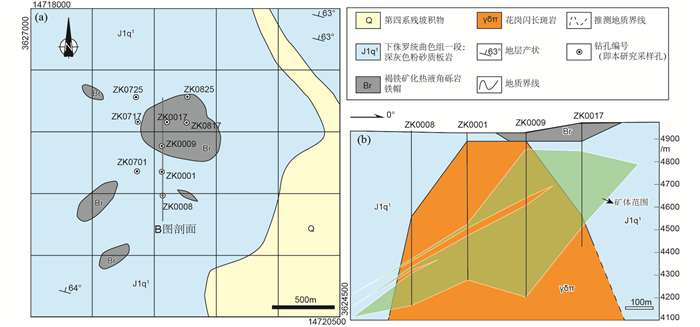
|
图 2 拿厅矿床平面地质图(a)和0号勘探线剖面图(b)(据西藏地质五队,2015①修改) Fig. 2 Geological map of Nating ore deposit (a) and cross section of No.0 prospecting line (b) |
①西藏地质五队.2015.西藏自治区改则县多不杂西铜矿拿厅矿段普查报告
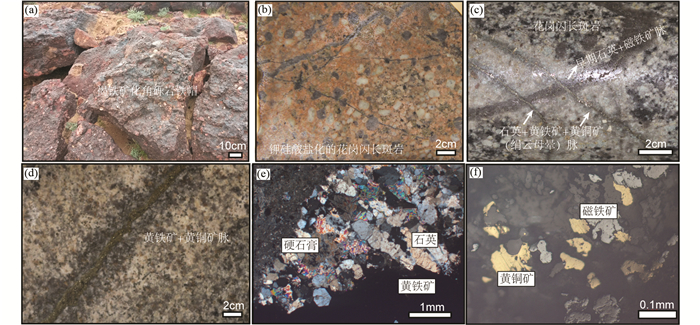
|
图 3 西藏拿厅Cu(Au)矿床蚀变矿化特征典型照片 (a)褐铁矿化角砾岩铁帽;(b)钾硅酸盐化的花岗闪长斑岩;(c)花岗闪长斑岩中晚期石英+黄铁矿+黄铜矿脉切穿早期石英+磁铁矿脉;(d)石英+多金属硫化物阶段的黄铁矿+黄铜矿脉;(e)石英+黄铁矿+硬石膏脉(正交);(f)钾硅酸盐化阶段的火山碎屑岩中与黄铜矿共生的星点状磁铁矿(反光) Fig. 3 Alteration and mineralization characteristics of the Nating porphyry Cu (Au) deposit, Tibet (a) breccia gossan with linonitization; (b) potassic granodiorite porphyry; (c) late-stage quartz-pyrite-chalcopyrite veinlet (sericite halo) cut early stage quartz-magnetite veinlet; (d) quartz-pyrite-chalcopyrite veinlet; (e) quartz-pyrite-anhydrite veinlet; (f) magnetite and chalcopyrite assemblage in potassic volcanoclastic rock |
由于拿厅花岗闪长斑岩为隐伏岩体,向西南侧倾伏,矿区地表目前所揭露的为大面积范围的青磐岩化带和少量黄铁-绢英岩化带,未见明显的钾硅化带;但是钻孔揭示在深部出现典型以黑云母化、磁铁矿化为主的钾质蚀变。矿体主要产于花岗闪长斑岩体内及其围岩的绢云岩化、青磐岩化变砂岩中,以铜矿化为主,并普遍伴生金。金属矿物包括黄铜矿、铜蓝、辉铜矿、黄铁矿、辉钼矿、黝铜矿、闪锌矿、方铅矿、磁铁矿等。非金属矿物主要为石英、斜长石、绢云母、黑云母、角闪石、绿帘石、绿泥石、方解石、硬石膏、粘土矿物等。根据矿物生成的先后顺序及矿物组合(图 3),主要分为:
1) 早期钾硅酸盐-硫化物阶段:主要表现为岩体中斑晶(主要是黑云母、石英等)次生加大,形成钾硅化,同时形成脉状和浸染状磁铁矿-黄铜矿-黄铁矿组合(图 3a)。
2) 石英-多金属硫化物阶段:该阶段为主要的成矿阶段,与绢云母化、粘土化和绿泥石-绿帘石化有关;并发育硬石膏,主要以脉状产出(图 3e)。矿化以细脉浸染状、网脉状黄铜矿+黄铁矿、细脉状辉钼矿+黄铁矿+黄铜矿、脉状黄铜矿矿物组合为主(图 3c-f)。
3) 石英+碳酸盐+黄铁矿阶段:为晚期低温阶段的产物,而黄铁矿后期氧化后,形成大面积的“火烧皮”,以及黄铜矿化氧化形成孔雀石+褐铁矿共生金属矿物组合。
2 样品采集及测试方法 2.1 样品采集本次研究采集样品均来自钻孔(ZK0009、ZK0717、ZK0817和ZK0725;图 2a),主要针对成矿花岗闪长斑岩以及同期火山岩(安山玢岩和英安岩)开展岩石化学、锆石年代学和锆石Hf-O同位素研究工作。所研究的火成岩样品都具有典型的斑状结构;斑晶含量为10%~30%,主要包括角闪石、黑云母、斜长石、石英等。其中花岗闪长斑岩主要由石英(20%~25%)、斜长石(40%~45%)、角闪石(10%~15%)、黑云母(5%~10%)、钾长石(10%~15%)等组成;而英安岩具有与花岗闪长斑岩相似的矿物成分,但基质矿物颗粒较小。安山玢岩具有高的角闪石(20%~25%)和斜长石(50%~55%)的矿物比例。但是,所有采集的样品都经历了一定程度的蚀变。
针对成矿物质来源,主要采集成矿花岗闪长斑岩的石英斑晶,以及早期钾硅酸盐-硫化物阶段和石英-多金属硫化物阶段的各类脉体、弥散性或星点状蚀变-矿化,挑选其中矿石矿物(黄铁矿、黄铜矿、辉锑矿、磁铁矿)和脉石矿物(石英、硬石膏)开展氢-氧-硫同位素研究工作。
2.2 锆石SIMS U-Pb定年和氧同位素待测锆石与Plesovice、Qinghu、Penglai锆石标样在中国科学院地质与地球物理研究所离子探针实验室制靶。所有锆石颗粒都经过反射和透射光学显微镜以及扫描电镜-阴极发光照相,观察锆石的内部结构。挑选颗粒较大、无裂隙和包裹体、环带清楚的锆石进行标记。在中国科学院地质与地球物理研究所离子探针实验室CAMECA IMS-1280二次离子质谱仪上进行U-Pb年代学和锆石氧同位素测试(方法详见Li et al., 2009)。锆石U-Pb定年中采用O2-一次离子,束流强度在10~15nA,束斑大小为20×30μm,标样与样品以1:3比例交替测定。利用标准锆石Plesovice (337.13±0.37Ma,Sláma et al., 2008)校正获得锆石Pb/U分馏,以长期监测标准样品获得的标准偏差(1SD=1.5%,Li et al., 2010)和单点测试内部精度共同传递得到样品单点误差,利用标准样品Qinghu (159.5±0.2Ma,Li et al., 2009)作为未知样监测数据精确度。普通Pb校正利用实测的204 Pb。单点分析的同位素比值及年龄误差均为1σ,U-Pb平均年龄误差为95%置信度。数据结果采用ISOPLOT软件进行处理(Ludwig, 2003)。锆石氧同位素分析流程参见Li et al. (2010),采用133Cs+一次离子,束流大小为1~2nA,分析区域约为20×20μm。二次离子以-10kV高压激发,采用多接收方式以两个法拉第杯分别接收16O和18O,单点内部精度优于0.3‰ (2SE)。利用Penglai氧同位素标准锆石(δ18O=5.31±0.10‰)校正仪器质量分馏,以Qinghu锆石(δ18O=5.4±0.2‰)作为未知样进行质量监控。
2.3 锆石Hf同位素本次锆石的LA-ICP-MS Lu-Hf同位素测试工作在中国科学院地质与地球物理研究所多接收激光剥蚀电感耦合等离子质谱(MC-LA-ICPMS)上完成。仪器的运行条件及详细的分析过程可参见(Wu et al., 2006)。在之前的U-Pb定年的锆石上进行Lu-Hf同位素的分析测定,激光束斑选择50~65 μm,略大于之前的SIMS年龄和氧同位素测定束斑,以便与氧同位素测试点一致。标准物质测定中,GJ-1的176Hf/177Hf加权平均值为0.282021±0.000007 (2σ, MSWD=0.8, n=25),与推荐值0.282015±0.000019 (2σ, n=25)近似(Elhlou et al., 2006);MUD的176Hf/177Hf加权平均值为0.282500±0.000007 (2σ, MSWD=1.6, n=24),与推荐值0.282504±0.000044 (2σ, n=158)近似(Woodhead and Hergt, 2005)。
2.4 岩石主量和微量元素在野外地表和系统的钻孔观察基础上,选择矿区内出露的各种岩石类型进行全岩的地球化学分析。选取相对较新鲜的岩石先在刚玉鄂板破碎机中进行粗碎,然后再细碎机上碎至200目,所有样品加工均在无污染设备中进行。实验均在核工业北京地质研究院分析测试研究中心完成。全岩主量元素数据采用顺序式X射线荧光光谱仪(XRF-1500)测得,FeO利用湿法化学测定而得;微量元素采用美国Finnian MAT公司生产的ICP-MS Element测试。主量元素分析精度和准确度优于5%,微量元素分析的精度和准确度一般优于10%,稀土元素优于5%。
2.5 氢-氧-硫稳定同位素氢、氧和硫同位素的测试工作在核工业北京地质研究院分析测试研究中心完成。测试前首先将矿石样品破碎到40~60目,在双目镜下手工挑选出待测矿物。而含有其他矿物包裹体或连生体的单矿物样品,进一步研磨到更细粒级,然后重复上述步骤,直至单矿物的纯度>99%。将石英和黄铁矿样品分别浸泡到HCl和HF溶液中,置于60℃的电热板上加热30min,然后用去离子水清洗,超声振荡10min。样品在去离子水中浸泡2~3天,每天清洗一次。
氢-氧同位素使用MAT-252质谱,其中H同位素数据均为相对国际标准V-SMOW之值,O同位素数据均为相对国际标准SMOW之值。分析精度分别为±2‰和±0.2‰。
硫同位素所用仪器为Delta-S气体同位素比值质谱仪,在真空系统和高温条件下把硫酸盐和硫化物转化为纯净的SO2气体,以备IRMS分析测量,测定其34S与32S的比值。硫同位素数据以传统的per mil的形式表示δ34S‰,硫同位素的参考标准为Cañon Diable Troilite (CDT),根据实验室的对同一样品的重复测试,总的分析误差小于0.20‰。
3 测试结果 3.1 锆石SIMS U-Pb定年和Hf-O同位素大多数锆石自形,平均晶体长度从50到250μm,长度与宽度的比例从2︰1到3︰1,长-短柱状形式。锆石为透明的,无色至淡色褐色,并在CL图像表现出岩浆振荡环带。年龄结果列于表 2。大多数分析结果分布在谐和线附近(图 4),并得到的206Pb/238U加权平均年龄可以用来解释岩体锆石的结晶时间,并近似为岩体的侵入年龄。
|
|
表 2 拿厅矿区岩浆岩锆石SIMS U-Pb年龄 Table 2 Zircon SIMS U-Pb isotopic data of magmatic rocks in Nating deposit |

|
图 4 拿厅矿区岩浆岩锆石SIMS年龄图谱(a-c)和与临近地堡那木岗矿区发表年龄对比(d) 数据来源:花岗闪长斑岩来自1-林彬等(2016);二长花岗斑岩来自2-乔东海等(2017);3-韦少港等(2017) Fig. 4 Zircon SIMS U-Pb age diagrams of magmatic rocks from the Nating porphyry Cu (Au) deposit (a-c) and comparison with published U-Pb ages (d) Literature data: granodiorite porphyry (1) from Lin et al. (2016); monzonitic granite porphyry (2 and 3) from Qiao et al. (2017) and Wei et al. (2017) |
成矿花岗闪长斑岩(0009-386),有较为均一的Th/U比值,在0.37~0.62之间,f206均小于0.6%,所有测试点均落在协和线上。获得的协和年龄118.8±1.0Ma(MSWD=0.2,图 4a),与208Pb/236U加权平均年龄为118.8±1.1 Ma(MSWD=0.44,图 4b)一致。而火山岩围岩中,安山玢岩(0825-350)的Th/U比值落于0.37~0.65之间,除去4号点(表 2)有较大208Pb/236U年龄(326.6Ma)外,其余测试点落于协和线附近,获得的208Pb/236U加权平均年龄为120.8±1.2 Ma(MSWD=0.81,图 4c);英安岩(0817-346)锆石的Th/U比值落于0.28~0.64之间,除去点5的208Pb/236U年龄(147.2Ma)较大外,其余4个年龄位于118~120Ma之间(图 4d)。
对于锆石的Hf-O同位素(表 3),与成矿有关的花岗闪长斑岩(0009-386)有着较为一致的锆石Hf-O同位素比值(图 5),176Lu/177Hf比值(< 0.002),176Hf/177Hf同位素比值为0.282821~0.282864, εHf(t)值在4.29~5.83之间。锆石的δ18O也较为集中,在6.40‰~6.97‰之间。安山玢岩(0825-350)中除~327Ma年龄的锆石εHf(t)值为-0.95外,其余锆石εHf(t)值在-0.54~9.88之间,氧同位素δ18O在5.11‰~6.77‰之间。英安岩(0817-346)中除年龄为~147.2Ma的捕获锆石,其余锆石的Hf和O同位素较为一致,εHf(t)值为11.41~12.73,δ18O为5.07‰~5.34‰。
|
|
表 3 西藏拿厅岩浆岩锆石Hf-O同位素数据 Table 3 Zircon Hf-O isotopic data of igneous rocks in Nating deposit |
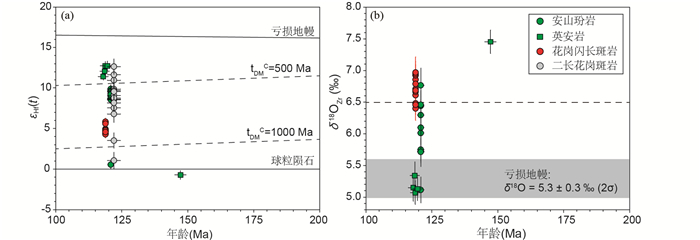
|
图 5 拿厅岩浆岩锆石Hf同位素-年龄(a)和锆石氧同位素-时间年龄(b) 二长花岗斑岩的数据韦少港等(2017) Fig. 5 Zircon Hf-O isotopic values vs. Age (Ma) for magmatic rocks from the Nating porphyry Cu (Au) deposit Literature data of monzonitic granite porphyry are from Wei et al. (2017) |
所有分析结果列于表 4中。拿厅岩浆岩岩石基本落在花岗闪长质-英安质岩浆的区域中(图 6a)。在SiO2-K2O图中, 拿厅岩浆岩成分大部分落入钙碱性-高钾钙碱性系列;而少量位于低钾拉斑系列,可能是由于蚀变造成的(如粘土化蚀变) (图 6b)。拿厅火山岩和侵入岩具有相似的球粒陨石标准化稀土元素配分模式和原始地幔标准化微量元素配分模式(图 7),所有岩石都表现出轻稀土(LREE)相对富集的特征,Eu异常不明显,微量元素显示富集大离子亲石元素(LILE)以及Nb、Ta亏损。
|
|
表 4 拿厅斑岩铜金矿中岩浆岩的岩石化学成分表(主量元素:wt%;稀土和微量元素:×10-6) Table 4 Chemical compositions of magmatic rocks in the Nating porphyry Cu (Au) deposit (major elements: wt%; trace elements: ×10-6) |
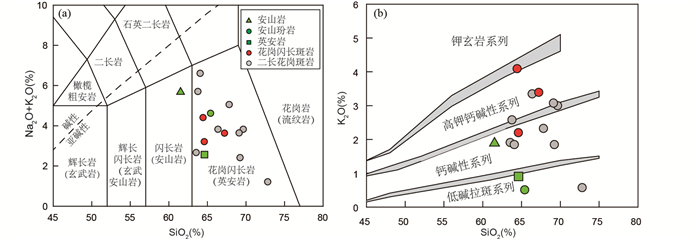
|
图 6 拿厅岩浆岩SiO2-(Na2O+K2O) (a, 据Middlemost, 1994)和SiO2-K2O图解(b, 据Peccerillo and Taylor, 1976) 主量元素去除挥发分后换算到100%;其中二长花岗斑岩数据来自乔东海等(2017),图 7同 Fig. 6 Plots of SiO2 vs. Na2O+K2O (a, after Middlemost, 1994) and SiO2 vs. K2O (b, after Peccerillo and Taylor, 1976) of magmatic rocks at the Nating deposit Major elements are recalculated to 100%. Literature data of monzonitic granite porphyry are from Qiao et al. (2017), also in the Fig. 7 |

|
图 7 拿厅矿床岩浆岩球粒陨石标准化稀土元素配分图(a)和原始地幔标准化微量元素蛛网图(b)(标准化值据Sun and McDonough, 1989) Fig. 7 Chondrite-normalized REE (a) and primitive mantle-normalized trace element patterns (b) for the Nating magmatic rocks (normalization values after Sun and McDonough, 1989) |
拿厅矿床岩浆-热液阶段各类矿物的H-O同位素分析测试结果及计算出对应流体H-O同位素结果见表 5和图 8。
|
|
表 5 拿厅矿床岩浆-热液矿物H-O同位素组成 Table 5 Hydrogen-oxygen isotopic data of quartz, magnetite and anhydrite from the Nating deposit |

|
图 8 拿厅Cu(Au)矿床成矿流体δD-δ18O图解 其中酸性岩浆范围来自Taylor (1992),高温火山气体来自Giggenbach (1992),残余岩浆水来自Taylor (1974);西藏地热水来自郑淑惠等(1982);灰色五角星代表假设的δ18O=7‰, δD=-35‰的初始流体同位素组成,两条同位素演化趋势线分别来自于Shmulovich et al. (1999)和Harris et al. (2005),表明流体在经历相分离过程后气相和液相的同位素组成 Fig. 8 δD vs. δ18O composition of waters in hydrothermal fluids derived from measured isotopic composition of magmatic and alteration minerals O-H isotopic values of primary magmatic water, high-temperture vapor, residual magmatic water, and geothermal water (Tibet) are from Taylor (1992), Giggenbach (1992), Taylor (1974), and Zheng et al. (1982), respectively. Gray star represents the O-H isotopic composition (δ18O=7‰ and δD=-35‰) of primary fluid. The isotopic evolution trends of vapor and brine are from Shmulovich et al. (1999) and Harris et al. (2005) |
代表岩浆期的花岗闪长斑岩中石英斑晶的H-O同位素范围(δ18O=10.2‰~11.0‰,δD=-87.9‰~-82.0‰),与其平衡的热液H-O同位素范围为(δ18O=9.8‰~10.6‰,δD=-87.9‰~-82.0‰;对应750℃时,依据流体包裹体均一温度估计;乔东海等,2017),落于残余岩浆水附近(图 8)。成矿早期钾硅酸盐化阶段中,脉石英的H-O同位素较为集中(δ18O=9.8‰~10.0‰,δD=-74.9‰~-66.8‰),与其平衡的热液H-O同位素范围为δ18O=7.6‰~7.7‰(对应500℃时;乔东海等,2017),大部分落于残余岩浆水范围内。而脉体中磁铁矿的δ18O为3.3‰~5.4‰,与其平衡的热液氧同位素为4.5‰~6.6‰(对应500℃时);火山岩中的星点状磁铁矿则显示较高的δ18O值,为10.8‰,与其平衡的热液δ18O=12.0‰(对应500℃时;乔东海等,2017)。石英+多金属硫化物阶段中硬石膏的氧同位素δ18O为5.0‰~10.8‰,对应流体的δ18O为5.1‰~10.9‰(在400~200℃温度下单个样品由于分馏值较小,基本保持不变,表 5和图 8)。
对于拿厅矿床的硫酸盐和硫化物硫同位素研究表明(表 6、图 9),其中早期钾硅酸盐化阶段的黄铁矿硫同位素值在-5.5‰~-3.6‰之间,黄铜矿硫同位素值为-3.1‰。在石英-多金属硫化物阶段,辉锑矿硫同位素-5.9‰,黄铁矿硫同位素值δ34S在-8.8‰~-4.3‰之间,3件硬石膏硫同位素值δ34S在+10.9‰和+13.8‰之间(图 10)。
|
|
表 6 拿厅矿床硫化物和硬石膏S同位素组成 Table 6 Sulfur isotopic data of sulfides and anhydrite from the Nating deposit |

|
图 9 拿厅硫化物和硫酸盐硫同位素直方图(a)和石英+多金属硫化物阶段硬石膏及共生黄铁矿对δ34S-Δδ34S硫同位素图解(b) 文献数据来自乔东海等(2017) Fig. 9 Histogram of S isotopic compositions for sulfide and sulfate (a) and δ34S vs. Δδ34S diagram of anhydrite-pyrite pairs (b) Literature data of pyrite plotted in figure from Qiao et al. (2017) |
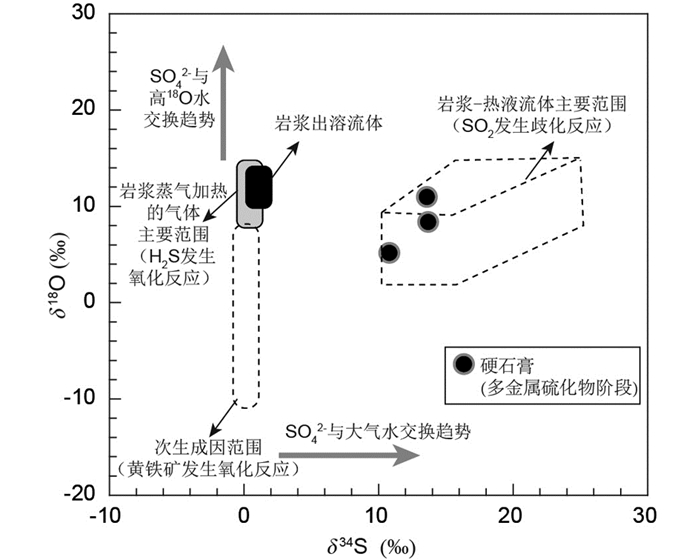
|
图 10 拿厅斑岩Cu(Au)矿床硬石膏δ34S-δ18O图解(底图据Rye, 2005) Fig. 10 δ34S vs. δ18O diagram for anhydrite in the Nating porphyry Cu (Au) deposit (modified after Rye, 2005) |
拿厅铜金矿床属于典型斑岩型铜金矿床,其成矿与岩体关系密切,加之拿厅岩浆岩锆石的Th/U比值普遍大于0.1,为岩浆锆石成因,且锆石晶体的振荡环带也常是判别岩浆锆石的重要标志,故本次应用SIMS获得的锆石U-Pb年龄可以近似代表该矿床成矿时代。总结前人研究发现花岗闪长斑岩与二长花岗斑岩形成于122~111Ma(林彬等,2016;乔东海等,2017;韦少港等,2017)。本次应用SIMS开展锆石U-Pb年代学研究,结果显示拿厅矿区内围岩火山岩和侵入到火山岩中的成矿期花岗闪长斑岩主要形成在121~118Ma,成岩年龄相对集中(图 4d)。拿厅岩浆岩年龄与多龙矿集区其它斑岩-浅成低温矿床的成岩成矿年龄相似(总结于Li et al., 2017b和表 7中),其形成与多龙矿集区多不杂、波龙、拿顿、色那、拿若和铁格隆南(荣那)矿床为同一期构造-岩浆作用形成,成岩-成矿峰期为120~118Ma。
|
|
表 7 西藏多龙矿集区金属矿床成岩-成矿时代汇总 Table 7 Summary of the ages of magmatism and mineralization in the Duolong ore district, Tibet |
利用锆石Lu-Hf同位素组成来探讨岩浆源区和成因(Wu et al., 2006;Kemp et al., 2007)。利用锆石Lu-Hf同位素特征完整地研究斑岩矿床各类岩浆作用的岩浆源区特征与演化过程(Zhao et al., 2014),应用锆石的氧同位素示踪岩浆岩母岩性质等方面,也具有不可或缺的重要作用(Li et al., 2009, 2010)。一般来说岩浆岩锆石的氧同位素若在5.3±0.6‰范围内(2σ; Valley et al., 1998; Valley, 2003),其岩浆源区与亏损地幔平衡;若锆石拥有小于6.5‰的氧同位素特征,则可解释为锆石平衡的熔体中具有非常少的地壳物质组成;而若锆石δ18O大于6.5‰,那么在其形成过程中壳源贡献的比例较大(Valley, 2003; Hawkesworth and Kemp, 2006; Kemp et al., 2007)。本次研究结果显示矿区内火山岩中除少数U-Pb年龄较老的锆石显示源区较为富集外,其它火山岩的锆石Hf-O同位素均显示较为亏损的特征(图 11,80%~90%的幔源物质组成),而成矿花岗闪长斑岩较同期火山岩(安山玢岩和英安岩)显示相对富集的特点(图 11),暗示其岩浆源区壳源物质的比例较大,可能和深部经历MASH过程(Hildreth and Moorbath, 1988)有关。而锆石Hf-O同位素二元模拟显示拿厅成矿岩体和矿集区内多不杂和波龙,以及班怒带北带的白弄矿床有相似的Hf-O同位素组成,即岩浆源区为60%~80%的幔源物质,以及20%~40%的壳源物质混合而成。
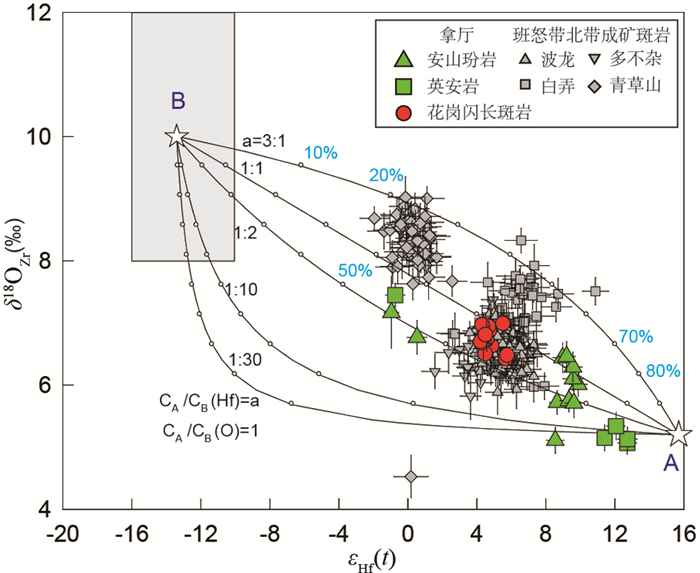
|
图 11 拿厅铜矿主要岩浆岩Hf-O同位素二元混合模拟图解 班公湖北带主要矿床中的成矿斑岩的锆石Hf-O数据来自Li et al.(2013, 2017a);对于地幔端元组分(端元A,εHf(t)=15.7,δ18O=5.2‰)则主要选择矿集区内最基性的辉绿岩(Li et al., 2015);对于地壳物质Hf-O同位素(端元B,εHf(t)=-13.8,δ18O=10.0‰)的组分,主要利用羌塘南缘早奥陶世S型花岗岩的Hf同位素反算至120Ma (选择锆石Hf同位素反算值的中位数和25%~75%分布所显示的比例圈定Hf同位素初始值范围,Hu et al., 2015),而氧同位素主要根据S型花岗岩已发表锆石氧同位素的值进行假设(Kemp et al., 2007),其中a值为端元A和端元B的Hf元素含量的比值,混合线上的点(蓝字)表示10%的步长 Fig. 11 Zircon Hf-O isotopic composition and binary mixing model for the magmatism at Nating deposit Data sources: The other porphyry deposits from Li et al.(2013, 2017a); The compositions of the mantle zircon from the diabase in the ore district are assumed as εHf(t)=15.7 and δ18O=5.2‰ (Li et al., 2015), and the Hf-O isotopic features of the crustal zircon come from the Early Ordovician S-type granite from the southern Qiangtang terrane (for Hf isotopes, we choose the median value of the published data of Hu et al. (2015), and recalculated to the 120Ma, and shade the area of initial Hf ratios as the 25% and 75% distribution of these data) and the published zircon oxygen isotopes from the S-type granite worldwide (Kemp et al., 2007); The character 'a' is the ratio of Hf concentration in the parental mantle magma (A) over crustal (B) melt indicated for each curves, and the small open circles on the curves represent 10% mixing increments |
对于成矿物质,结合前人黄铁矿硫同位素数据(乔东海等, 2017),显示拿厅硫化物的硫同位素(图 9a)主要集中在-8‰~-4‰之间,变化范围较窄。而若计算与硫化物平衡的流体中H2S的δ34S组成(表 6),总体上偏离幔源硫的δ34S组成,与火山岩中H2S的硫同位素组成相似。成矿早期的流体中H2S的δ34S值为-6.2‰~-2.3‰,可能与岩浆早期SO2去气作用有关(Rye, 2005)。值得注意的是,在辉锑矿-黄铁矿-石英脉中,辉锑矿与黄铁矿的δ34S组成显示不平衡的特点,说明在形成辉锑矿时流体中的总硫组成或者SO42-/H2S发生明显改变。而由硫酸盐和硫化物组成的矿床中的总硫的同位素组成,结合地质事实可以为理解硫的来源和矿物形成提供有用信息(Field et al., 2005)。本研究对多金属硫化物阶段硬石膏的硫-氧同位素结果显示(图 10),形成该时期硫化物和硫酸盐主要是由于岩浆热液流体中SO2发生歧化反应所致(Rye, 2005)。同时应用δ34S-δ34S图解计算该热液阶段的总硫值δ34S∑S(图 9a),并用硫同位素平衡温度计(表 6)计算该阶段温度,硫同位素平衡温度给出的结果279~316℃,该温度值显示该阶段流体可能以H2S为主(Field et al., 2005; Rye, 2005)。计算所得多金属硫化物阶段的总硫值δ34S∑S为14.5‰,明显大于硫酸盐的δ34S(应该落于硫酸盐和共生硫化物之间,Wilson et al., 2007),这说明当流体演化至多金属硫化物阶段时总硫值发生改变,或者演化过程中热液流体的SO42-(SO2)/H2S发生改变所致,这一变化可能和深部岩浆房基性岩浆补给有关(Hedenquist et al., 2017)。而利用H-O同位素组成显示成矿流体基本来自残余岩浆水(图 8),即岩浆发生去气所用的残余岩浆水,与硫同位素显示的去气作用相吻合。
4.3 岩石成因、构造背景和成岩-成矿过程分析研究表明,流体蚀变过程中REE和高场强元素一般是不活波的,可以用来探讨岩浆岩的成因(Li et al., 2013;Zhang et al., 2018)。拿厅岩浆岩富集LREE和LILE,以及明显亏损Nb、Ta和Ti的特征,说明具有俯冲带岛弧岩浆的特征(Hawkesworth et al., 1993; Pearce and Peate, 1995),这样的特征也反映到在构造判别图解上落于活动大陆边缘的火山岩岛弧区域(图 12a-c)。而由于角闪石相对富集Nb,可能造成在岩浆房与其平衡的熔体在部分熔融过程中具有低的Nb/Ta比值,即岩浆演化过程中可能有角闪石的分离结晶(图 12d, f)。而拿厅岩浆的低的(La/Yb)N值显示基本不具备埃达克质的特征(图 12f);而大部分花岗闪长斑岩和二长花岗斑岩具有高的Sr/Y比值(图 12e)。结合矿区同时代岩浆岩的演化趋势,这种高的Sr/Y比值是由于岩浆演化过程中角闪石等结晶分异造成的(Richards, 2013;Sun et al., 2018);进一步指示没有地壳增厚过程,显示其形成于正常的大陆边缘弧背景。另外,稀土元素中Eu异常不明显(图 7a),指示拿厅岩浆源区较少斜长石发生分离结晶作用,暗示岩浆是一套富水的岩浆(Richards, 2013)。
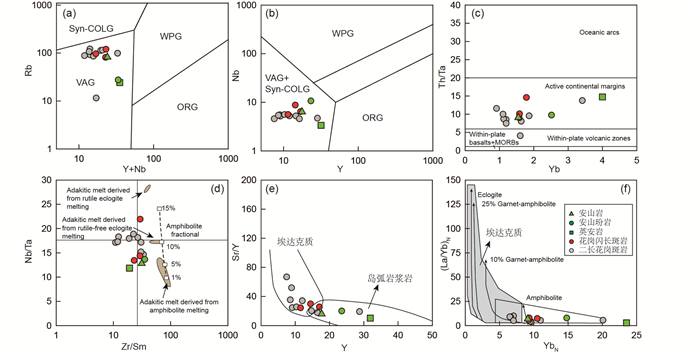
|
图 12 拿厅矿区岩浆岩构造判别图解 Fig. 12 Tectonic discrimination diagrams of the Nating magmatic rocks (a) Rb vs. (Y+Nb), (b) Nb vs. Y, (c) Th/Ta vs. Yb (Pearce et al., 1984; Schandl and Gorton, 2002); (d) Zr/Sm vs. Nb/Ta (Foley et al., 2002); (e) Sr/Y vs. Y, (f) (La/Yb)N vs. YbN (Hou et al., 2004) |
结合区域上班公湖-怒江多金属成矿带北带多龙矿集区斑岩矿床的研究(李光明等, 2007, 2015;李金祥等,2008;Li et al., 2013, 2017a; Zhu et al., 2015; 唐菊兴等,2016;Lin et al., 2017; Sun et al., 2017; Zhang et al., 2018),本文认为,拿厅斑岩铜金矿床形成于班公湖-怒江洋向北俯冲阶段,矿区早期的火山岩显示早期幔源岩浆和MASH过程混入壳源岩浆的过程(10%~20%壳源物质),成矿期花岗闪长斑岩和二长花岗斑岩则是MASH过程逐渐演化(壳源-幔源混合,估算有20%~40%壳源物质)的产物。而在形成拿厅斑岩铜金矿成矿岩浆的过程中,基本没有发生陆壳加厚的过程(图 12e, f);岩浆演化过程中较少斜长石分离结晶,主要为角闪石和钛铁氧化物结晶。拿厅成矿流体O-H同位素与残余岩浆水范围(图 8)一致,暗示成矿流体主要来源于岩浆的流体出溶过程;结合硫化物-硫酸盐的S同位素和成矿斑岩锆石Hf-O同位素特征显示成矿物质主要来源于俯冲交代的地幔楔。而在多金属硫化物阶段发生热液体系总硫值变化或者SO42-(SO2)/H2S比值变化说明成矿过程中可能发生深部岩浆房基性岩浆补给作用(Hedenquist et al., 2017)。
5 结论(1) 锆石U-Pb年代学表明,西藏拿厅铜金矿床与多龙矿集区多不杂、波龙、拿顿、色那、拿若和铁格隆南(荣那)矿床为同一期岩浆-热液成矿事件,成岩-成矿峰期为120~118Ma。
(2) 拿厅斑岩铜金矿床形成于班公湖-怒江洋向北俯冲阶段,矿区早期的火山岩显示早期幔源岩浆和MASH过程混入壳源岩浆的过程(10%~20%壳源物质),成矿期花岗闪长斑岩和二长花岗斑岩则是MASH过程逐渐演化(壳源-幔源混合,估算有20%~40%壳源物质)的产物。
(3) 在形成拿厅斑岩铜金矿成矿岩浆的过程中,岩浆演化过程中主要为角闪石结晶分异,指示岩浆具有富水的特征。拿厅成矿流体和成矿物质主要来源于岩浆,与岩浆房流体出溶过程有关。
致谢 中国地质科学院矿产资源研究所唐菊兴研究员、宋扬副研究员、王立强副研究员和孙嘉副研究员在野外和室内工作中给予了大力指导和无私帮助,在此表示感谢;同时感谢审稿专家和编辑提供的建设性意见。
Amelin Y, Lee DC, Halliday AN and Pidgeon RT. 1999. Nature of the Earth's earliest crust from hafnium isotopes in single detrital zircons. Nature, 399(6733): 252 DOI:10.1038/20426 |
Barnes HL. 1979. Solubilities of ore minerals. In: Barnes HL (ed.). Geochemistry of Hydrothermal Ore Deposits. 2nd Edition. New York: John Wiley and Sons, 404-460
|
Baxter AT, Aitchison JC and Zyabrev SV. 2009. Radiolarian age constraints on Mesotethyan ocean evolution, , their implications for development of the Bangong-Nujiang suture, Tibet. Journal of the Geological Society, 166(4): 689-694 DOI:10.1144/0016-76492008-128 |
Bottinga Y and Javoy M. 1973. Comments on oxygen isotope geothermometry. Earth, Planetary Science Letters, 20(2): 250-265 |
Chen HA, Zhu XP, Ma DF, Huang HX, Li GM, Li YB, Li YC, Wei LJ and Liu CQ. 2013. Geochronology, geochemistry of the Bolong porphyry Cu-Au deposit, Tibet, its mineralizing significance. Acta Geologica Sinica, 87(10): 1593-1611 (in Chinese with English abstract) |
Clayton RN, O'Neil JR and Mayeda TK. 1972. Oxygen isotope exchange between quartz, water. Journal of Geophysical:Research, 77(17): 3057-3067 DOI:10.1029/JB077i017p03057 |
Cooke DR, Hollings P and Walsh JL. 2005. Giant porphyry deposits:Characteristics, distribution, , tectonic controls. Economic Geology, 100(5): 801-818 |
Ding S, Tang JX, Zheng WB, Yang C, Zhang Z, Wang Q and Wang YY. 2017. Geochronology, geochemistry of Naruo porphyry Cu (Au) deposit in Duolong ore-concentrated area, Tibet, , their geological significance. Earth Science, 42(1): 1-23 (in Chinese with English abstract) |
Duan ZM, Li GM, Zhang H, Li YX and Duan YY. 2013. Zircon U-Pb age, geochemical characteristics of the quartz monzobiorite, metallogenic background of the Sena gold deposit in Duolong metallogenic concentrated area, Tibet. Journal of Jilin University (Earth Science Edition), 43(6): 1864-1877 (in Chinese with English abstract) |
Elhlou S, Belousova E, Griffin WL, Pearson NJ and O'Reilly SY. 2006. Trace element, isotopic composition of GJ-red zircon standard by laser ablation. Geochimica et Cosmochimica Acta, 70(S18): A158 |
Fang X, Tang JX, Song Y, Yang C, Ding S, Wang YY, Wang Q, Sun XG, Li YB, Wei LJ, Zhang Z, Yang HH, Gao K and Tang P. 2015. Formation Epoch of the South Tiegelong supelarge epithermal Cu (Au-Ag) deposit in Tibet, its geological implications. Acta Geoscientia Sinica, 36(2): 168-176 (in Chinese with English abstract) |
Field CW, Zhang L, Dilles JH, Rye RO and Reed MH. 2005. Sulfur, oxygen isotopic record in sulfate, sulfide minerals of early, deep, pre-Main Stage porphyry Cu-Mo, late Main Stage base-metal mineral deposits, Butte district, Montana. Chemical Geology, 215(1-4): 61-93 DOI:10.1016/j.chemgeo.2004.06.049 |
Foley S, Tiepolo M and Vannucci R. 2002. Growth of early continental crust controlled by melting of amphibolite in subduction zones. Nature, 417(6891): 837-840 DOI:10.1038/nature00799 |
Giggenbach WF. 1992. Isotopic shifts in waters from geothermal, volcanic systems along convergent plate boundaries, their origin. Earth, Planetary Science Letters, 113(4): 495-510 |
Griffin WL, Pearson NJ, Belousova E, Jackson SE, Van Achterbergh E, O'Reilly SY and Shee SR. 2000. The Hf isotope composition of cratonic mantle:LAM-MC-ICPMS analysis of zircon megacrysts in kimberlites. Geochimica et Cosmochimica Acta, 64(1): 133-147 DOI:10.1016/S0016-7037(99)00343-9 |
Griffin WL, Wang X, Jackson SE, Pearson NJ, O'Reilly SY, Xu XS and Zhou XM. 2002. Zircon chemistry, magma mixing, SE China:In-situ analysis of Hf isotopes, Tonglu, Pingtan igneous complexes. Lithos, 61(3-4): 237-269 DOI:10.1016/S0024-4937(02)00082-8 |
Harris AC, Golding SD and White NC. 2005. Bajo de la Alumbrera copper-gold deposit:Stable isotope evidence for a porphyry-related hydrothermal system dominated by magmatic aqueous fluids. Economic Geology, 100(5): 863-886 |
Hawkesworth CJ, Gallagher K, Hergt JM and McDermott F. 1993. Mantle, slab contributions in arc magmas. Annual Review of Earth, Planetary Sciences, 21: 175-204 DOI:10.1146/annurev.ea.21.050193.001135 |
Hawkesworth CJ and Kemp AI. 2006. Evolution of the continental crust. Nature, 443(7113): 811-817 DOI:10.1038/nature05191 |
Hedenquist JW and Lowenstern JB. 1994. The role of magmas in the formation of hydrothermal ore deposits. Nature, 370(6490): 519-527 DOI:10.1038/370519a0 |
Hedenquist JW, Arribas R A and Aoki M. 2017. Zonation of sulfate, sulfide minerals, isotopic composition in the far southeast porphyry, Lepanto epithermal Cu-Au deposits, Philippines. Resource Geology, 67(2): 174-196 |
Hildreth W and Moorbath S. 1988. Crustal contributions to arc magmatism in the Andes of Central Chile. Contributions to Mineralogy, Petrology, 98(4): 455-489 DOI:10.1007/BF00372365 |
Hou ZQ, Gao YF, Qu XM, Rui ZY and Mo XX. 2004. Origin of adakitic intrusives generated during Mid-Miocene east-west extension in southern Tibet. Earth, Planetary Science Letters, 220(1-2): 139-155 |
Hu PY, Zhai QG, Jahn BM, Wang J, Li C, Lee HY and Tang SH. 2015. Early Ordovician granites from the South Qiangtang terrane, northern Tibet:Implications for the Early Paleozoic tectonic evolution along the Gondwanan proto-Tethyan margin. Lithos, 220-223: 318-338 DOI:10.1016/j.lithos.2014.12.020 |
Kapp P, Yin A, Harrison TM and Ding L. 2005. Cretaceous-Tertiary shortening, basin development, , volcanism in central Tibet. Geological Society of America Bulletin, 117(7-8): 865-878 |
Kemp AIS, Hawkesworth CJ, Foster GL, Paterson BA, Woodhead JD, Hergt JM, Gray CM and Whitehouse MJ. 2007. Magmatic, crustal differentiation history of granitic rocks from Hf-O isotopes in zircon. Science, 315(5814): 980-983 DOI:10.1126/science.1136154 |
Kerrich R, Goldfarb R, Groves D, Garwin S and Jia Y. 2000. The characteristics, origins, , geodynamic settings of supergiant gold metallogenic provinces. Science in China (Series D), 43(1): 1-68 |
Li GM, Li JX, Qin KZ, Zhang TP and Xiao B. 2007. High temperature, salinity, strong oxidation ore-forming fluid at Duobuza gold-rich porphyry copper deposit in the Bangonghu tectonic belt, Tibet:Evidence from fluid inclusions. Acta Petrologica Sinica, 23(5): 935-952 (in Chinese with English abstract) |
Li GM, Zhang XN, Qin KZ, Sun XG, Zhao JX, Yin XB, Li JX and Yuan HS. 2015. The telescoped porphyry-high sulfidation epithermal Cu (-Au) mineralization of Rongna deposit in Duolong ore cluster at the southern margin of Qiangtang Terrane, Central Tibet:Integrated evidence from geology, hydrothermal alteration, sulfide assemblages. Acta Petrologica Sinica, 31(8): 2307-2324 (in Chinese with English abstract) |
Li GM, Qin KZ, Li JX, Evans NJ, Zhao JX, Cao MJ and Zhang XN. 2017a. Cretaceous magmatism, metallogeny in the Bangong-Nujiang metallogenic belt, central Tibet:Evidence from petrogeochemistry, zircon U-Pb ages, , Hf-O isotopic compositions. Gondwana Research, 41: 110-127 DOI:10.1016/j.gr.2015.09.006 |
Li JX, Qin KZ and Li GM. 2006. Basic characteristics of gold-rich porphyry copper deposits, their ore sources, evolving processes of high oxidation magma, ore-forming fluid. Acta Petrologica Sinica, 22(3): 678-688 (in Chinese with English abstract) |
Li JX, Li GM, Qin KZ and Xiao B. 2008. Geochemistry of porphyries, volcanic rocks, ore-forming geochronology of Duobuza gold-rich porphyry copper deposit in Bangonghu belt, Tibet:Constraints on metallogenic tectonic settings. Acta Petrologica Sinica, 24(3): 531-543 (in Chinese with English abstract) |
Li JX, Qin KZ, Li GM, Xiao B, Zhao JX and Chen L. 2011. Magmatic-hydrothermal evolution of the Cretaceous Duolong gold-rich porphyry copper deposit in the Bangongco metallogenic belt, Tibet:Evidence from U-Pb, 40Ar/39Ar geochronology. Journal of Asian Earth Sciences, 41(6): 525-536 DOI:10.1016/j.jseaes.2011.03.008 |
Li JX, Qin KZ, Li GM, Xiao B, Zhao JX, Cao MJ and Chen L. 2013. Petrogenesis of ore-bearing porphyries from the Duolong porphyry Cu-Au deposit, central Tibet:Evidence from U-Pb geochronology, petrochemistry, Sr-Nd-Hf-O isotope characteristics. Lithos, 160-161: 216-227 DOI:10.1016/j.lithos.2012.12.015 |
Li JX, Qin KZ, Li GM, Richards JP, Zhao JX and Cao MJ. 2014. Geochronology, geochemistry, , zircon Hf isotopic compositions of Mesozoic intermediate-felsic intrusions in central Tibet:Petrogenetic, tectonic implications. Lithos, 198-199: 77-91 DOI:10.1016/j.lithos.2014.03.025 |
Li JX, Qin KZ, Li GM, Zhao JX and Cao MJ. 2015. Petrogenesis of diabase from accretionary prism in the southern Qiangtang terrane, central Tibet:Evidence from U-Pb geochronology, petrochemistry, Sr-Nd-Hf-O isotope characteristics. Island Arc, 24(2): 232-244 DOI:10.1111/iar.2015.24.issue-2 |
Li JX, Qin KZ, Li GM, Evans NJ, Zhao JX, Cao MJ and Huang F. 2016. The Nadun Cu-Au mineralization, central Tibet:Root of a high sulfidation epithermal deposit. Ore Geology Reviews, 78: 371-387 DOI:10.1016/j.oregeorev.2016.04.019 |
Li JX, Qin KZ, Li GM, Evans NJ, Zhao JX, Yue YH and Xie J. 2018. Volatile variations in magmas related to porphyry Cu-Au deposits:Insights from amphibole geochemistry, Duolong district, central Tibet. Ore Geology Reviews, 95: 649-662 DOI:10.1016/j.oregeorev.2018.03.019 |
Li QL, Li XH, Liu Y, Wu FY, Yang JH and Mitchell RH. 2010. Precise U-Pb, Th-Pb age determination of kimberlitic perovskites by secondary ion mass spectrometry. Chemical Geology, 269(3-4): 396-405 DOI:10.1016/j.chemgeo.2009.10.014 |
Li XH, Liu Y, Li QL, Guo CH and Chamberlain KR. 2009. Precise determination of Phanerozoic zircon Pb/Pb age by multicollector SIMS without external standardization. Geochemistry, Geophysics, Geosystems, 10(4): 10.1029/2009GC002400 |
Li XK, Li C, Sun ZM and Wang M. 2017b. Origin, tectonic setting of the giant Duolong Cu-Au deposit, South Qiangtang Terrane, Tibet:Evidence from geochronology, geochemistry of Early Cretaceous intrusive rocks. Ore Geology Reviews, 80: 61-78 DOI:10.1016/j.oregeorev.2016.06.025 |
Li YB, Duo J, Zhong WT, Li YC, Qiangba WD, Chen HQ, Liu HF, Zhang JS, Zhang TP, Xu ZZ, Fan AH and Suolang WQ. 2012. An exploration model of the Duobuza Porphyry Cu-Au deposit in Gaize Country, Northern Tibet. Geology, Prospecting, 48(2): 274-287 (in Chinese with English abstract) |
Lin B, Chen YC, Tang JX, Song Y, Wang Q, Feng J, Li YB, Tang XQ, Lin X, Liu ZB, Wang YY, Fang X, Yang C, Yang HH, Fei F, Li L and Gao K. 2016. Zircon U-Pb ages, Hf isotopic composition of the ore-bearing porphyry in Dibao Cu(Au) deposit, Duolong ore concentration area, Xizang (Tibet), , its geological significance. Geological Review, 62(6): 1565-1578 (in Chinese) |
Lin B, Tang JX, Chen YC, Song Y, Hall G, Wang Q, Yang C, Fang X, Duan JL, Yang HH, Liu ZB, Wang YY and Feng J. 2017. Geochronology, genesis of the tiegelongnan porphyry Cu(Au) deposit in Tibet:Evidence from U-Pb, Re-Os dating, Hf, S, , H-O isotopes. Resource Geology, 67(1): 1-21 |
Liu H, Li GM, Huang HX, Cao HW, Yuan Q, Li YX, Ouyang Y, Lan SS, Lü MH and Yan GQ. 2018. Petrogenesis of Late Cretaceous Jiangla'angzong I-type granite in central Lhasa Terrane, Tibet, China:Constraints from whole-rock geochemistry, zircon U-Pb geochronology, , Sr-Nd-Pb-Hf isotopes. Acta Geologica Sinica, 92(4): 1396-1414 DOI:10.1111/1755-6724.13634 |
Liu WL, Xia B, Zhong Y, Cai JX, Li JF, Liu HF, Cai ZR and Sun ZL. 2014. Age, composition of the Rebang Co, Julu ophiolites, central Tibet:Implications for the evolution of the Bangong Meso-Tethys. International Geology Review, 56(4): 430-447 DOI:10.1080/00206814.2013.873356 |
Ludwig KR. 2003. ISOPLOT 3.0:A Geochronological Toolkit for Microsoft Excel. Berkeley: Berkeley Geochronology Center
|
Middlemost EAK. 1994. Naming materials in the magma/igneous rock system. Earth-Science Reviews, 37(3-4): 215-224 DOI:10.1016/0012-8252(94)90029-9 |
Ohmoto H and Rye RO. 1979. Isotopes of sulfur and carbon. In: Barnes HL (ed.). Geochemistry of Hydrothermal Ore Deposits. New York: John Wiley and Sons, 509-567
|
Pan GT, Wang LQ, Li RS, Yuan SH, Ji WH, Yin FG, Zhang WP and Wang BD. 2012. Tectonic evolution of the Qinghai-Tibet Plateau. Journal of Asian Earth Sciences, 53: 3-14 DOI:10.1016/j.jseaes.2011.12.018 |
Pearce JA, Harris NWW and Tindle AG. 1984. Trace element discrimination diagrams for the tectonic interpretation of granitic rocks. Journal of Petrology, 25(4): 956-983 DOI:10.1093/petrology/25.4.956 |
Pearce JA and Peate DW. 1995. Tectonic implications of the composition of volcanic arc magmas. Annual Review of Earth, Planetary Sciences, 23: 251-285 DOI:10.1146/annurev.ea.23.050195.001343 |
Peccerillo A and Taylor SR. 1976. Geochemistry of Eocene calc-alkaline volcanic rocks from the Kastamonu area, northern Turkey. Contributions to Mineralogy, Petrology, 58(1): 63-81 DOI:10.1007/BF00384745 |
Qiao DH, Zhao YY, Wang A, Li YB, Guo S, Li XS and Wang S. 2017. Geochronology, fluid inclusions, geochemical characteristics of Dibao Cu(Au) deposit, Duolong ore concentration area, Xizang (Tibet), , its genetic type. Acta Geologica Sinica, 91(7): 1542-1564 (in Chinese with English abstract) |
Qin KZ and Ishihara S. 1998. On the possibility of porphyry copper mineralization in Japan. International Geology Review, 40(6): 539-551 DOI:10.1080/00206819809465223 |
Qin KZ, Tosdal RM, Li GM, Zhang Q and Li JL. 2005. Formation of the Miocene porphyry Cu (-Mo-Au) deposits in the Gangdese arc, southern Tibet, in a transitional tectonic setting. In: Mineral Deposit Research: Meeting the Global Challenge. Beijing: China University of Geology, China Geological Society, 44-47
|
Qu XM and Xin HB. 2006. Ages, tectonic environment of the Bangong Co porphyry copper belt in western Tibet, China. Geological Bulletin of China, 25(7): 792-799 (in Chinese with English abstract) |
Qu XM, Fan SF, Ma XD and Song Y. 2015. Post-collisional copper ore deposits along Bangong Co-Nujiang metallogenic belt, Tibetan Plateau. Mineral Deposits, 34(3): 431-448 (in Chinese with English abstract) |
Richards JP. 2013. Giant ore deposits formed by optimal alignments, combinations of geological processes. Nature Geoscience, 6(11): 911-916 DOI:10.1038/ngeo1920 |
Rye RO. 2005. A review of the stable-isotope geochemistry of sulfate minerals in selected igneous environments, related hydrothermal systems. Chemical Geology, 215(1-4): 5-36 DOI:10.1016/j.chemgeo.2004.06.034 |
Schandl ES and Gorton MP. 2002. Application of high field strength elements to discriminate tectonic settings in VMS environments. Economic Geology, 97(3): 629-642 |
She HQ, Li JW, Ma DF, Li GM, Zhang DQ, Feng CY, Qu WJ and Pan GT. 2009. Molybdenite Re-Os, SHRIMP zircon U-Pb dating of Duobuza porphyry copper deposit in Tibet, its geological implications. Mineral Deposits, 28(6): 737-746 (in Chinese with English abstract) |
Shi RD, Yang JS, Xu ZQ and Qi XX. 2008. The Bangong Lake ophiolite (NW Tibet), its bearing on the tectonic evolution of the Bangong-Nujiang suture zone. Journal of Asian Earth Sciences, 32(5-6): 438-457 DOI:10.1016/j.jseaes.2007.11.011 |
Shmulovich KI, Landwehr D, Simon K and Heinrich W. 1999. Stable isotope fractionation between liquid, vapour in water-salt systems up to 600℃. Chemical Geology, 157(3-4): 343-354 DOI:10.1016/S0009-2541(98)00202-2 |
Sillitoe RH. 1997. Characteristics, controls of the largest porphyry copper-gold, epithermal gold deposits in the circum-Pacific region. Australian Journal of Earth Sciences, 44(3): 373-388 |
Sillitoe RH. 2010. Porphyry copper systems. Economic Geology, 105(1): 3-41 |
Sláma J, Košler J, Condon DJ, Crowley JL, Gerdes A, Hanchar JM, Horstwood MSA, Morris GA, Nasdala L, Norberg N, Schaltegger U, Schoene B, Tubrett MN and Whitehouse MJ. 2008. Plešovice zircon:A new natural reference material for U-Pb, Hf isotopic microanalysis. Chemical Geology, 249(1-2): 1-35 |
Song Y, Yang C, Wei SG, Yang HH, Fang X and Lu HT. 2018. Tectonic control, reconstruction, preservation of the Tiegelongnan Porphyry, epithermal overprinting Cu (Au) deposit, central Tibet, China. Minerals, 8(9): 398 DOI:10.3390/min8090398 |
Sun J, Mao JW, Beaudoin G, Duan XZ, Yao FJ, Ouyang HG, Wu Y, Li YB and Meng XY. 2017. Geochronology, geochemistry of porphyritic intrusions in the Duolong porphyry, epithermal Cu-Au district, central Tibet:Implications for the genesis, exploration of porphyry copper deposits. Ore Geology Reviews, 80: 1004-1019 DOI:10.1016/j.oregeorev.2016.08.029 |
Sun SS and McDonough WF. 1989. Chemical, isotopic systematics of oceanic basalts:Implications for mantle composition, processes. In:Saunders AD, Norry MJ (eds.). Magmatism in the Ocean Basins. Geological Society, London, Special Publication, 42(1): 313-345 DOI:10.1144/GSL.SP.1989.042.01.19 |
Sun X, Lu YJ, McCuaig TC, Zheng YY, Chang HF, Guo F and Xu LJ. 2018. Miocene ultrapotassic, high-Mg dioritic, , adakite-like rocks from Zhunuo in Southern Tibet:Implications for mantle metasomatism, porphyry copper mineralization in collisional orogens. Journal of Petrology, 59(3): 341-386 DOI:10.1093/petrology/egy028 |
Tang JX, Song Y, Wang Q, Lin B, Yang C, Guo N, Fang X, Yang HH, Wang YY, Gao K, Ding S, Zhang Z, Duan JL, Chen HQ, Su DK, Feng J, Liu ZB, Wei SG, He W, Song JL, Li YB and Wei LJ. 2016. Geological characteristics, exploration model of the Tiegelongnan Cu (Au-Ag) Deposit:The first ten million tons metal resources of a porphyry-epithermal deposit in Tibet. Acta Geoscientia Sinica, 37(6): 663-690 (in Chinese with English abstract) |
Taylor BE. 1992. Degassing of H2O from rhyolite magma during eruption, shallow intrusion, , the isotopic composition of magmatic water in hydrothermal systems. Geological Survey of Japan Memoir, 279: 190-195 |
Taylor HP. 1974. The application of oxygen, hydrogen isotope studies to problems of hydrothermal alteration, ore deposition. Economic Geology, 69(6): 843-883 |
Valley JW, Kinny PD, Schulze DJ and Spicuzza MJ. 1998. Zircon megacrysts from kimberlite:Oxygen isotope variability among mantle melts. Contributions to Mineralogy, Petrology, 133(1-2): 1-11 DOI:10.1007/s004100050432 |
Valley JW. 2003. Oxygen isotopes in zircon. Reviews in Mineralogy, Geochemistry, 53(1): 343-385 |
Wei SG, Tang JX, Song Y, Liu ZB, Wang Q, Lin B, Wang YY, Fang X, Yang HH and Feng J. 2017. Zircons LA-MC-ICP-MS U-Pb ages, petrochemical, petrological, its significance of the potassic monzonitic granite porphyry from the Duolong ore-concentrated district, Gaize County, Xizang (Tibet). Geological Review, 63(1): 189-206 (in Chinese with English abstract) |
Wilson AJ, Cooke DR, Harper BJ and Deyell CL. 2007. Sulfur isotopic zonation in the Cadia district, southeastern Australia:Exploration significance, implications for the genesis of alkalic porphyry gold-copper deposits. Mineralium Deposita, 42(5): 465-487 DOI:10.1007/s00126-006-0071-9 |
Woodhead JD and Hergt JM. 2005. A preliminary appraisal of seven natural zircon reference materials for in situ Hf isotope determination. Geostandards, Geoanalytical Research, 29(2): 183-195 DOI:10.1111/ggr.2005.29.issue-2 |
Wu FY, Yang YH, Xie LW, Yang JH and Xu P. 2006. Hf isotopic compositions of the standard zircons, baddeleyites used in U-Pb geochronology. Chemical Geology, 234(1-2): 105-126 DOI:10.1016/j.chemgeo.2006.05.003 |
Yang C, Tang JX, Wang YY, Yang HH, Wang Q, Sun XG, Feng J, Yin XB, Ding S, Fang X, Zhang Z and Li YB. 2014. Fluid, geological characteristics researches of southern Tiegelong epithemal porphyry Cu-Au deposit in Tibet. Mineral Deposits, 33(6): 1287-1305 (in Chinese with English abstract) |
Zhang KJ, Zhang YX, Tang XC and Xia B. 2012. Late Mesozoic tectonic evolution, growth of the Tibetan plateau prior to the Indo-Asian collision. Earth-Science Reviews, 114(3-4): 236-249 DOI:10.1016/j.earscirev.2012.06.001 |
Zhang XN, Li GM, Qin KZ, Lehmann B, Li JX, Zhao JX, Cao MJ and Zou XY. 2018. Petrogenesis, tectonic setting of Early Cretaceous granodioritic porphyry from the giant Rongna porphyry Cu deposit, central Tibet. Journal of Asian Earth Sciences, 161: 74-92 DOI:10.1016/j.jseaes.2018.05.006 |
Zhao JX, Qin KZ, Li GM, Li JX, Xiao B, Chen L, Yang YH, Li C and Liu YS. 2014. Collision-related genesis of the Sharang porphyry molybdenum deposit, Tibet:Evidence from zircon U-Pb ages, Re-Os ages, Lu-Hf isotopes. Ore Geology Reviews, 56: 312-326 DOI:10.1016/j.oregeorev.2013.06.005 |
Zheng SH, Zhang ZF, Ni BL, Hou FG and Shen MZ. 1982. Hydrogen, oxygen isotopic studies of thermal waters in Xizang. Acta Scientiarum Naturalium Universitatis Pekinensis, (1): 99-106 (in Chinese with English abstract) |
Zheng YF. 1999. Oxygen isotope fractionation in carbonate, sulfate minerals. Geochemical Journal, 33(2): 109-126 DOI:10.2343/geochemj.33.109 |
Zhu DC, Zhao ZD, Niu YL, Dilek Y, Hou ZQ and Mo XX. 2013. The origin, pre-Cenozoic evolution of the Tibetan Plateau. Gondwana Research, 23(4): 1429-1454 DOI:10.1016/j.gr.2012.02.002 |
Zhu XP, Chen HA, Ma DF, Huang HX, Li GM, Li YB, Li YC, Wei LJ and Liu CQ. 2013. 40Ar/39Ar dating of hydrothermal K-feldspar, hydrothermal sericite from Bolong porphyry Cu-Au deposit in Tibet. Mineral Deposits, 32(5): 954-962 (in Chinese with English abstract) |
Zhu XP, Li GM, Chen HA, Ma DF and Huang HX. 2015. Zircon U-Pb, molybdenite Re-Os, K-feldspar 40Ar/39Ar dating of the Bolong porphyry Cu-Au deposit, Tibet, China. Resource Geology, 65(2): 122-135 |
Zhu XP, Chen HA, Liu HF, Ma DF, Li GM, Zhang H, Liu CQ and Wei LJ. 2015. Geochronology, geochemistry of porphyries from the Naruo porphyry copper deposit, Tibet, their metallogenic significance. Acta Geologica Sinica, 89(1): 109-128 (in Chinese with English abstract) |
Zhu XP, Li GM, Chen HA, Ma DF, Zhang H, Zhang H, Liu CQ and Wei LJ. 2017. Petrogenesis, metallogenic setting of porphyries of the Duobuza porphyry Cu-Au deposit, central Tibet, China. Ore Geology Reviews, 89: 858-875 DOI:10.1016/j.oregeorev.2017.07.013 |
陈华安, 祝向平, 马东方, 黄瀚霄, 李光明, 李玉彬, 李玉昌, 卫鲁杰, 刘朝强. 2013. 西藏波龙斑岩铜金矿床成矿斑岩年代学、岩石化学特征及其成矿意义. 地质学报, 87(10): 1593-1611. |
丁帅, 唐菊兴, 郑文宝, 杨超, 张志, 王勤, 王艺云. 2017. 西藏拿若斑岩型铜(金)矿含矿岩体年代学、地球化学及地质意义. 地球科学, 42(1): 1-23. DOI:10.3969/j.issn.1672-6561.2017.01.001 |
段志明, 李光明, 张晖, 李应栩, 段瑶瑶. 2013. 色那金矿石英二长闪长岩锆石U-Pb年龄与地球化学特征及其对成矿背景的约束. 吉林大学学报(地球科学版), 43(6): 1864-1877. |
方向, 唐菊兴, 宋杨, 杨超, 丁帅, 王艺云, 王勤, 孙兴国, 李玉彬, 卫鲁杰, 张志, 杨欢欢, 高轲, 唐攀. 2015. 西藏铁格隆南超大型浅成低温热液铜(金、银)矿床的形成时代及其地质意义. 地球学报, 36(2): 168-176. |
李光明, 李金祥, 秦克章, 张天平, 肖波. 2007. 西藏班公湖带多不杂超大型富金斑岩铜矿的高温高盐高氧化成矿流体:流体包裹体证据. 岩石学报, 23(5): 935-952. |
李光明, 张夏楠, 秦克章, 孙兴国, 赵俊兴, 印贤波, 李金祥, 袁华山. 2015. 羌塘南缘多龙矿集区荣那斑岩-高硫型浅成低温热液Cu-(Au)套合成矿:综合地质、热液蚀变及金属矿物组合证据. 岩石学报, 31(8): 2307-2324. |
李金祥, 秦克章, 李光明. 2006. 富金斑岩型铜矿床的基本特征、成矿物质来源与成矿高氧化岩浆-流体演化. 岩石学报, 22(3): 678-688. |
李金祥, 李光明, 秦克章, 肖波. 2008. 班公湖带多不杂富金斑岩铜矿床斑岩-火山岩的地球化学特征与时代:对成矿构造背景的制约. 岩石学报, 24(3): 531-543. |
李玉彬, 多吉, 钟婉婷, 李玉昌, 强巴旺堆, 陈红旗, 刘鸿飞, 张金树, 张天平, 徐志忠, 范安辉, 索朗旺钦. 2012. 西藏改则县多不杂斑岩型铜金矿床勘查模型. 地质与勘探, 48(2): 274-287. |
林彬, 陈毓川, 唐菊兴, 宋扬, 王勤, 冯军, 李彦波, 唐晓倩, 林鑫, 刘治博, 王艺云, 方向, 杨超, 杨欢欢, 费凡, 李力, 高轲. 2016. 西藏多龙矿集区地堡Cu(Au)矿床含矿斑岩锆石U-Pb测年、Hf同位素组成及其地质意义. 地质论评, 62(6): 1565-1578. |
乔东海, 赵元艺, 汪傲, 李玉彬, 郭硕, 李小赛, 王松. 2017. 西藏多龙矿集区地堡铜(金)矿床年代学、流体包裹体、地球化学特征及其成因类型研究. 地质学报, 91(7): 1542-1564. DOI:10.3969/j.issn.0001-5717.2017.07.009 |
曲晓明, 辛洪波. 2006. 藏西班公湖斑岩铜矿带的形成时代与成矿构造环境. 地质通报, 25(7): 792-799. DOI:10.3969/j.issn.1671-2552.2006.07.004 |
曲晓明, 范淑芳, 马旭东, 宋扬. 2015. 西藏班公湖-怒江成矿带上的碰撞后铜矿床. 矿床地质, 34(3): 431-448. |
佘宏全, 李进文, 马东方, 李光明, 张德全, 丰成友, 屈文俊, 潘桂棠. 2009. 西藏多不杂斑岩铜矿床辉钼矿Re-Os和锆石U-Pb SHRIMP测年及地质意义. 矿床地质, 28(6): 737-746. DOI:10.3969/j.issn.0258-7106.2009.06.003 |
唐菊兴, 宋扬, 王勤, 林彬, 杨超, 郭娜, 方向, 杨欢欢, 王艺云, 高轲, 丁帅, 张志, 段吉琳, 陈红旗, 粟登逵, 冯军, 刘治博, 韦少港, 贺文, 宋俊龙, 李彦波, 卫鲁杰. 2016. 西藏铁格隆南铜(金银)矿床地质特征及勘查模型——西藏首例千万吨级斑岩-浅成低温热液型矿床. 地球学报, 37(6): 663-690. |
韦少港, 唐菊兴, 宋扬, 刘治博, 王勤, 林彬, 王艺云, 方向, 杨欢欢, 冯军. 2017. 西藏改则多龙矿集区地堡那木岗矿床钾玄质二长花岗斑岩锆石LA-MC-ICP-MS U-Pb年龄、地球化学特征及其地质意义. 地质论评, 63(1): 189-206. |
杨超, 唐菊兴, 王艺云, 杨欢欢, 王勤, 孙兴国, 冯军, 印贤波, 丁帅, 方向, 张志, 李玉彬. 2014. 西藏铁格隆南浅成低温热液型-斑岩型Cu-Au矿床流体及地质特征研究. 矿床地质, 33(6): 1287-1305. DOI:10.3969/j.issn.0258-7106.2014.06.009 |
郑淑惠, 张知非, 倪葆龄, 候发高, 沈敏子. 1982. 西藏地热水氢氧稳定同位素研究. 北京大学学报(自然科学版), (01): 99-106. |
祝向平, 陈华安, 马东方, 黄瀚霄, 李光明, 李玉彬, 李玉昌, 卫鲁杰, 刘朝强. 2013. 西藏波龙斑岩铜金矿床钾长石和绢云母40Ar/39Ar年龄及其地质意义. 矿床地质, 32(5): 954-962. DOI:10.3969/j.issn.0258-7106.2013.05.007 |
祝向平, 陈华安, 刘鸿飞, 马东方, 李光明, 张红, 刘朝强, 卫鲁杰. 2015. 西藏拿若斑岩铜金矿床成矿斑岩年代学、岩石化学特征及其成矿意义. 地质学报, 89(1): 109-128. |
 2019, Vol. 35
2019, Vol. 35

